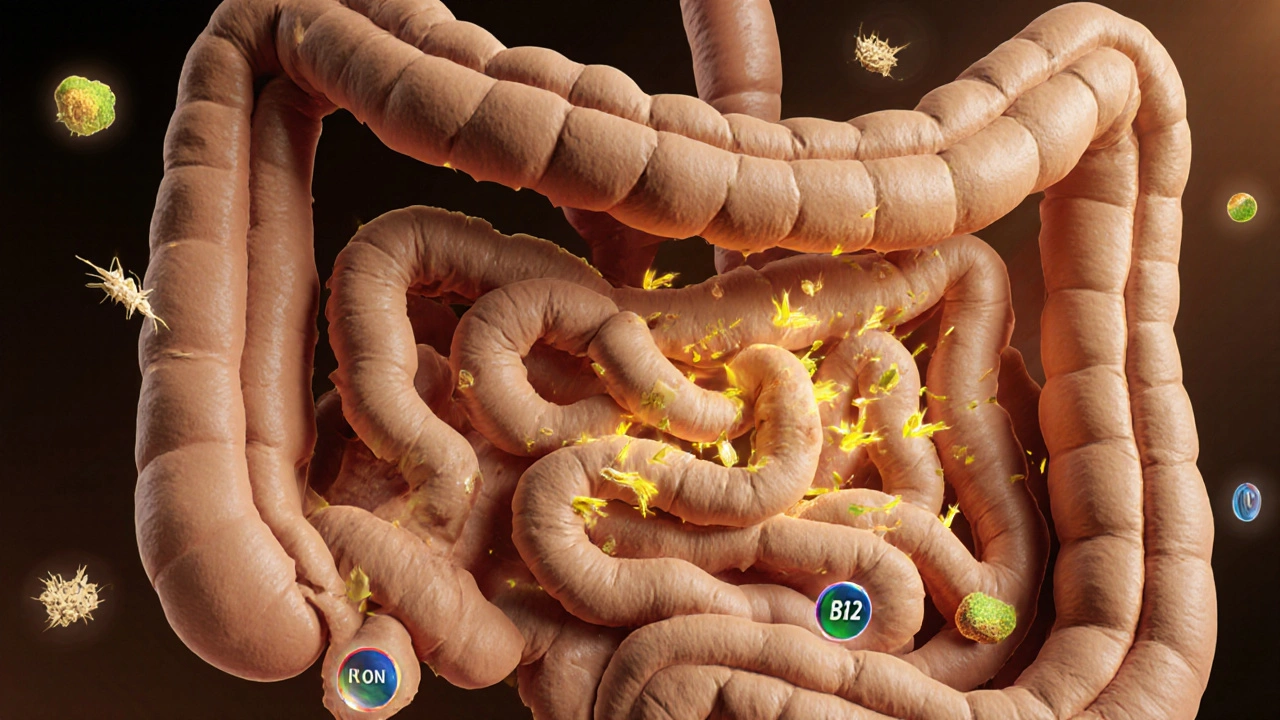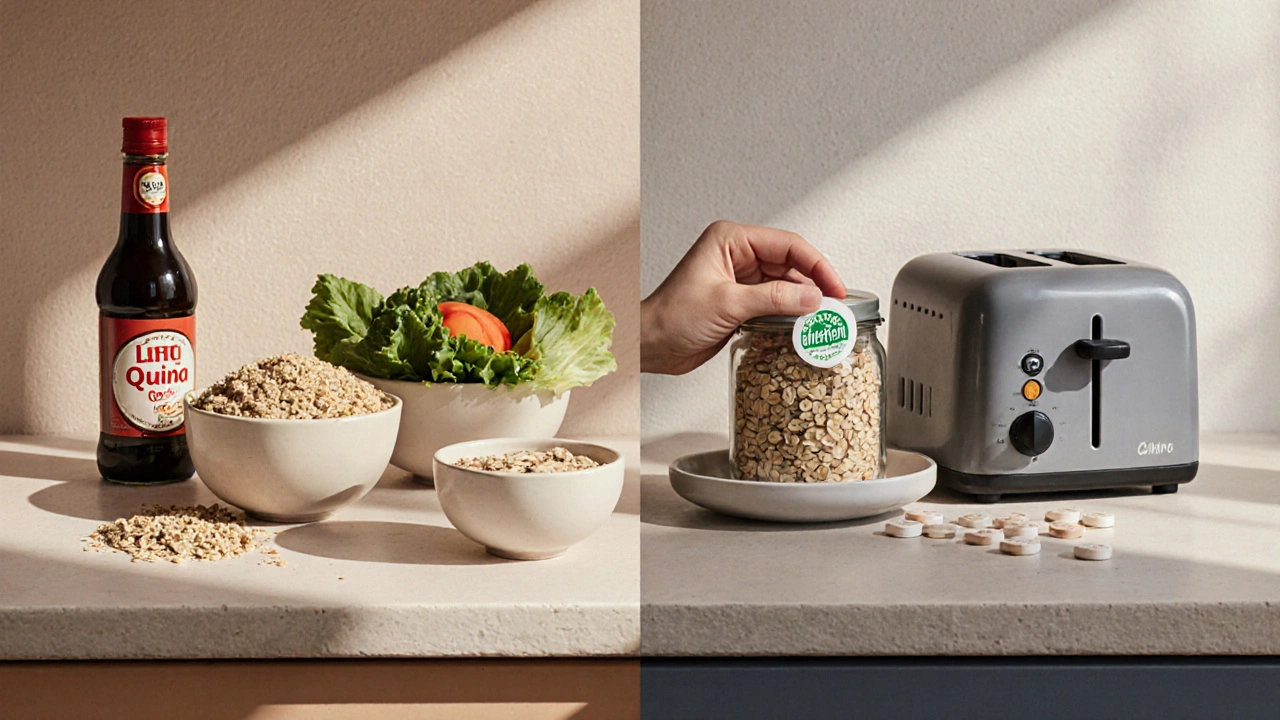Celiac Disease: How to Live Gluten-Free and Fix Nutrient Deficiencies

Nov, 23 2025
Living with celiac disease isn’t just about avoiding bread or pasta. It’s about protecting your body from damage that happens silently - inside your gut - every time you eat something containing gluten. For the 1 in 100 people worldwide who have this autoimmune condition, even a tiny crumb of wheat can trigger inflammation, wreck the lining of the small intestine, and block your body from absorbing vital nutrients. The good news? When you go completely gluten-free, your gut starts healing within days. The challenge? Most people still end up deficient in iron, vitamin D, calcium, and B vitamins - even after years on the diet.
What Exactly Happens When You Eat Gluten With Celiac Disease?
Your immune system doesn’t just react to gluten - it attacks your own small intestine. The villi, those tiny finger-like projections that absorb nutrients, get flattened. That’s why people with undiagnosed celiac often feel tired, have diarrhea, lose weight, or develop anemia. But it’s not always obvious. Some people have joint pain, skin rashes, or even infertility. Others feel fine - until a blood test shows low iron or bone density loss.
The trigger? Gluten - a protein found in wheat, barley, rye, and their cousins like spelt and triticale. It’s not just in bread. It’s in soy sauce, malt vinegar, processed meats, even some medications. And here’s the catch: you don’t need to eat a whole slice of bread to cause damage. As little as 50 milligrams of gluten - about the size of a crouton - can stop healing in half of patients, according to Dr. Alessio Fasano’s research.
The Only Treatment: 100% Gluten-Free, No Exceptions
There’s no pill, no shot, no cure. The only proven treatment is a lifelong, strict gluten-free diet. That means no exceptions. Not even on vacation. Not even if you think you’re "fine" after eating it.
Safe foods? Naturally gluten-free grains like rice, quinoa, buckwheat, millet, and certified gluten-free oats. Yes, oats - but only if they’re labeled gluten-free. Regular oats are often cross-contaminated during farming or processing. Studies show 95% of people with celiac can safely eat up to 50 grams of certified gluten-free oats per day, but 5% still react. Start slow. Monitor your symptoms.
What to avoid? Anything with wheat, barley, rye, or malt. Watch out for hidden sources: salad dressings, soups, candy, beer, and even some supplements. Labels say "wheat-free"? That doesn’t mean gluten-free. Always check for "gluten-free" certification. The FDA requires products with that label to contain less than 20 parts per million of gluten - the safest threshold.
Why You’re Still Deficient - Even on a Gluten-Free Diet
Here’s the hard truth: going gluten-free doesn’t automatically fix nutrient gaps. In fact, many gluten-free products are low in fiber, iron, and B vitamins because they’re made with refined rice or potato starch instead of whole grains.
At diagnosis, most people with celiac are deficient in:
- Iron - affects 12% to 63% of patients. Leads to fatigue, pale skin, and shortness of breath.
- Vitamin D - low in 37% to 75%. Weakens bones and increases risk of osteoporosis.
- Calcium - deficient in 25% to 40%. Directly linked to bone loss.
- Folate and B12 - critical for nerve function and red blood cell production.
- Magnesium - often overlooked. Needed for muscle function and energy.
Even after years on the diet, 41% of people on Celiac.com forums still report low iron levels. Why? Because your gut is still healing. Absorption takes time. And many gluten-free foods aren’t fortified like regular bread and cereal.

Supplements That Actually Work - And How to Take Them
Don’t just grab any multivitamin. You need targeted, high-quality supplements based on your blood work.
- Iron: 18 mg daily for women, 8 mg for men. Take with vitamin C (like orange juice) to boost absorption. Avoid calcium supplements at the same time - they block iron uptake.
- Vitamin D: 600-800 IU daily is the standard, but most people with celiac need 2,000-5,000 IU to correct deficiency. Get your levels checked every 6 months.
- Calcium: 1,000-1,200 mg daily. Choose calcium citrate - it’s better absorbed than carbonate, especially if you have low stomach acid.
- B12: 250-500 mcg daily. Sublingual (under-the-tongue) forms work best. Some people need injections if absorption is severely impaired.
- Magnesium: 400 mg daily. Glycinate or citrate forms are easiest on the gut.
- Folate: 400 mcg daily. Avoid folic acid - choose methylfolate instead. It’s the active form your body can actually use.
One patient on Dr. de María’s blog reported her chronic fatigue vanished after adding 1,000 mcg sublingual B12 and 400 mg magnesium daily. Her blood tests improved in 3 months.
How to Avoid Hidden Gluten - The Real Killer
Most people who still feel sick after going gluten-free aren’t cheating. They’re being exposed without knowing it.
Common culprits:
- Shared toasters - crumbs from regular bread stick around for months.
- Condiment jars - peanut butter, jam, or butter used on gluten-containing bread then dipped into again.
- Restaurant kitchens - even if they have a "gluten-free menu," 85% of people on Reddit’s r/celiac say cross-contamination is their biggest problem.
- Medications - 30% of prescriptions use gluten as a filler. Check the Gluten-Free Drug Database from the University of Chicago.
- Supplements - many use wheat starch or maltodextrin. Look for "gluten-free" on the label.
Fix it: get a dedicated toaster, use squeeze bottles for condiments, and carry gluten-free dining cards in 30+ languages (available from the Celiac Disease Foundation). Ask restaurants: "Do you have a separate prep area and clean utensils for gluten-free orders?" If they say "yes," ask for proof - like a training certificate.

Monitoring Progress: Blood Tests and Bone Scans
Don’t assume you’re fine just because you feel better. Healing takes time.
Follow-up schedule:
- Month 3: Blood test for tTG-IgA antibodies. Levels should drop by at least 50%.
- Month 6: Full nutrient panel - iron, ferritin, vitamin D, calcium, B12, folate.
- Year 1: Repeat antibody test. If still high, you’re still being exposed.
- Every 2-3 years: DXA bone scan to check bone density. Most people see improvement within 1-2 years of strict dieting.
Some people never fully heal. Up to 60% of adults still show intestinal damage after two years - even with perfect diet adherence. That’s called non-responsive celiac disease. It may need further testing, like a capsule endoscopy, or even immunosuppressive therapy.
Cost, Convenience, and the Real World
Gluten-free bread costs 159% more than regular bread. A box of gluten-free pasta can be $5 instead of $2. Groceries are more expensive. Insurance rarely covers supplements or dietitian visits.
But here’s the trade-off: untreated celiac increases your risk of lymphoma, osteoporosis, and other autoimmune diseases. The cost of ignoring it is far higher.
Smart fixes:
- Cook more at home - rice, quinoa, beans, eggs, and veggies are naturally gluten-free and cheap.
- Buy in bulk - gluten-free oats, rice flour, and nuts are cheaper in warehouse stores.
- Use apps like Nima - a handheld sensor that tests food for gluten in 2 minutes. It’s 90% accurate at detecting 20 ppm or more.
There are now over 350% more gluten-free products in U.S. stores than in 2015. You’re not alone. But you still need to be smart.
What’s Next? The Future of Celiac Care
Scientists are working on drugs that could break down gluten before it triggers an immune response. Enzymes like Latiglutenase are in late-stage trials. A vaccine called Nexvax2 showed promise but failed in Phase 2. Non-invasive tests - like the new epithelial lymphogram - might soon replace biopsies.
But for now, the best treatment is still the same as it was in the 1950s: avoid gluten. Eat real food. Fix your nutrients. Get tested. Stay vigilant.
Healing isn’t instant. But with the right approach, most people feel like themselves again - full of energy, pain-free, and in control of their health.
Can I eat oats if I have celiac disease?
Yes - but only if they’re labeled certified gluten-free. Regular oats are often contaminated with wheat during farming or processing. About 95% of people with celiac can safely eat up to 50 grams per day. Start slowly and watch for symptoms. If you still feel unwell after 2-4 weeks, stop and talk to your doctor.
Why do I still feel tired after going gluten-free?
Fatigue often means you’re still deficient - most likely in iron, B12, or vitamin D. Your gut is still healing and absorbing nutrients slowly. Get blood tests to check levels. Many people need higher-dose supplements for 6-12 months. Also, check for hidden gluten exposure - even tiny amounts can cause ongoing inflammation.
Do I need to take supplements forever?
Not necessarily. Once your gut heals and nutrient levels return to normal, you may be able to reduce or stop some supplements. But many people continue taking vitamin D and calcium long-term because gluten-free diets often lack these nutrients. Get blood tests every 6-12 months to guide your needs.
Is a gluten-free diet healthy for someone without celiac disease?
Not unless you have a medical reason. Many gluten-free products are lower in fiber, iron, and B vitamins. They’re often higher in sugar and fat to improve taste. Unless you have celiac, non-celiac gluten sensitivity, or a wheat allergy, there’s no proven benefit - and you might miss out on key nutrients.
How do I know if my gluten-free food is really safe?
Look for "gluten-free" certification from trusted organizations like GFCO or NSF. Avoid products that just say "wheat-free." Check ingredient lists for barley, malt, or modified food starch (unless labeled gluten-free). When in doubt, use a Nima Sensor or contact the manufacturer directly.
Can celiac disease be cured?
No - not yet. Celiac disease is a lifelong genetic condition. But strict, lifelong gluten avoidance allows the gut to heal completely and prevents serious complications. With proper care, people with celiac can live full, healthy lives with normal life expectancy.
